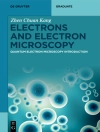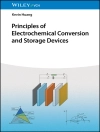Bioelectrochemistry is a fast growing field at the interface between electrochemistry and other sciences such as biochemistry, analytical chemistry and medicinal chemistry. In the recent years, the methods and the understanding of the fundamentals have seen significant progress, which has led to rapid development in the field.
Here, the expert editors have carefully selected contributions to best reflect the latest developments in this hot and rapidly growing interdisciplinary topic. The resulting excellent and timely overview of this multifaceted field covers recent methodological advances, as well as a range of new applications for analytical detection, drug screening, tumor therapy, and for energy conversion in biofuel cells.
This book is a must-have for all Electrochemists, Biochemists, Analytical Chemists, and Medicinal Chemists.
विषयसूची
Preface
AMPEROMETRIC BIOSENSORS
Introduction
Criteria for ‘Good’ Biosensor Research
Defining a Standard for Characterizing Biosensor Performances Success Stories in Biosensor Research
Conclusion
IMAGING OF SINGLE BIOMOLECULES BY SCANNING TUNNELING MICROSCOPY
Introduction
Interfacial Electron Transfer in Molecular and Protein Film Voltammetry
Theoretical Notions in Bioelectrochemistry towards the Single-Molecule Level
In Situ Imaging of Bio-related Molecules and Linker Molecules for Protein Voltammetry with Single-Molecule and Sub-molecular Resolution
Imaging of Intermediate-Size Biological Structures: Lipid Membranes and Insulin
Interfacial Electrochemistry and In Situ Imaging of Redox Metalloproteins and Metalloenzymes at the Single-Molecule Level
Some Concluding Observations and Outlooks
APPLICATIONS OF NEUTRON REFLECTIVITY IN BIOELECTROCHEMISTRY
Introduction
Theoretical Aspects of Neutron Scattering
Experimental Aspects
Selected Examples
Summary and Future Aspects
MODEL LIPID BILAYERS AT ELECTRODE SURFACES
Introduction
Biomimetic Membranes: Scope and Requirements
Electrochemical Impedance Spectroscopy
Formation of Lipid Films in Biomimetic Membranes
Various Types of Biomimetic Membranes
Conclusions
ENZYMATIC FUEL CELLS
Introduction
Bioanodes for Glucose Oxidation
Biocathodes
Assembled Biofuel Cells
Conclusions and Future Outlook
RAMAN SPECTROSCOPY OF BIOMOLECULES AT ELECTRODE SURFACES
Introduction
Raman Spectroscopy
SERS and Surface-Enhanced Resonant Raman Spectroscopy
Comparison of SE(R)RS and Fluorescence for Biological Studies
Surfaces for SERS
Plasmonic Surfaces
SERS Surfaces for Electrochemistry
Tip-Enhanced Raman Spectroscopy
SE(R)RS of Biomolecules
Conclusion
MEMBRANE ELECTROPORATION IN HIGH ELECTRIC FIELDS
Introduction
Electrodeformation and Electroporation of Membranes in the Fluid Phase
Response of Gel-Phase Membranes
Effects of Membrane Inclusions and Media on the Response and Stability of Fluid Vesicles in Electric Fields
Application of Vesicle Electroporation
Conclusions and Outlook
ELECTROPORATION FOR MEDICAL USE IN DRUG AND GENE ELECTROTRANSFER
Introduction
A List of Definitions
How We Understand Permeabilization at the Cellular and Tissue Level
Basic Aspects of Electroporation that are of Particular Importance for Medical Use
How to Deliver Electric Pulses in Patient Treatment
Treatment and Post-treatment Management
Clinical Results with Electrochemotherapy
Use in Internal Organs
Gene Electrotransfer
Conclusions
लेखक के बारे में
Richard C. Alkire is Professor Emeritus of Chemical & Biomolecular Engineering Charles and Dorothy Prizer Chair at the University of Illinois, Urbana, USA. He obtained his degrees at Lafayette College and University of California at Berkeley. He has received numerous prizes, including Vittorio de Nora Award and Lifetime National Associate award from National Academy.
Dieter M. Kolb is Professor of Electrochemistry at the University of Ulm, Germany. He received his undergraduate and Ph D degrees at the Technical University of Munich. He was a Postdoctoral Fellow at Bell Laboratories, Murray Hill, NJ, USA. He worked as a Senior Scientist at the Fritz-Haber-Institute of the Max-Planck-Society, Berlin and completed his habilitation at the Free University of Berlin, where he also was Professor. Prof. Kolb has received many prizes and is a member of several societies.
Jacek Lipkowski is Professor at the Department of Chemistry and Biochemistry at the University of Guelph, Canada. His research interests focus on surface analysis and interfacial electrochemistry. He has authored over 120 publications and is a member of several societies, including a Fellow of the International Society of Electrochemistry.












